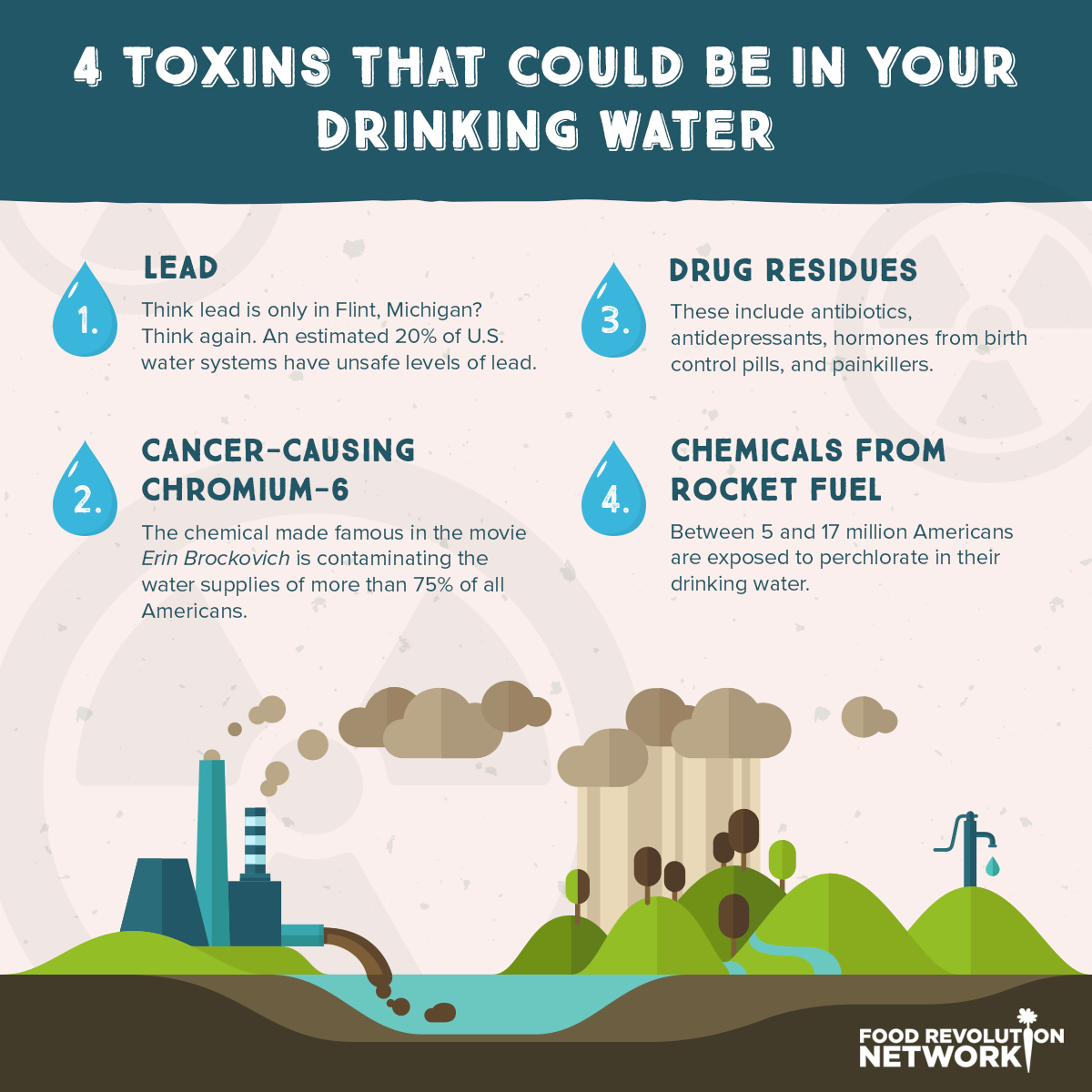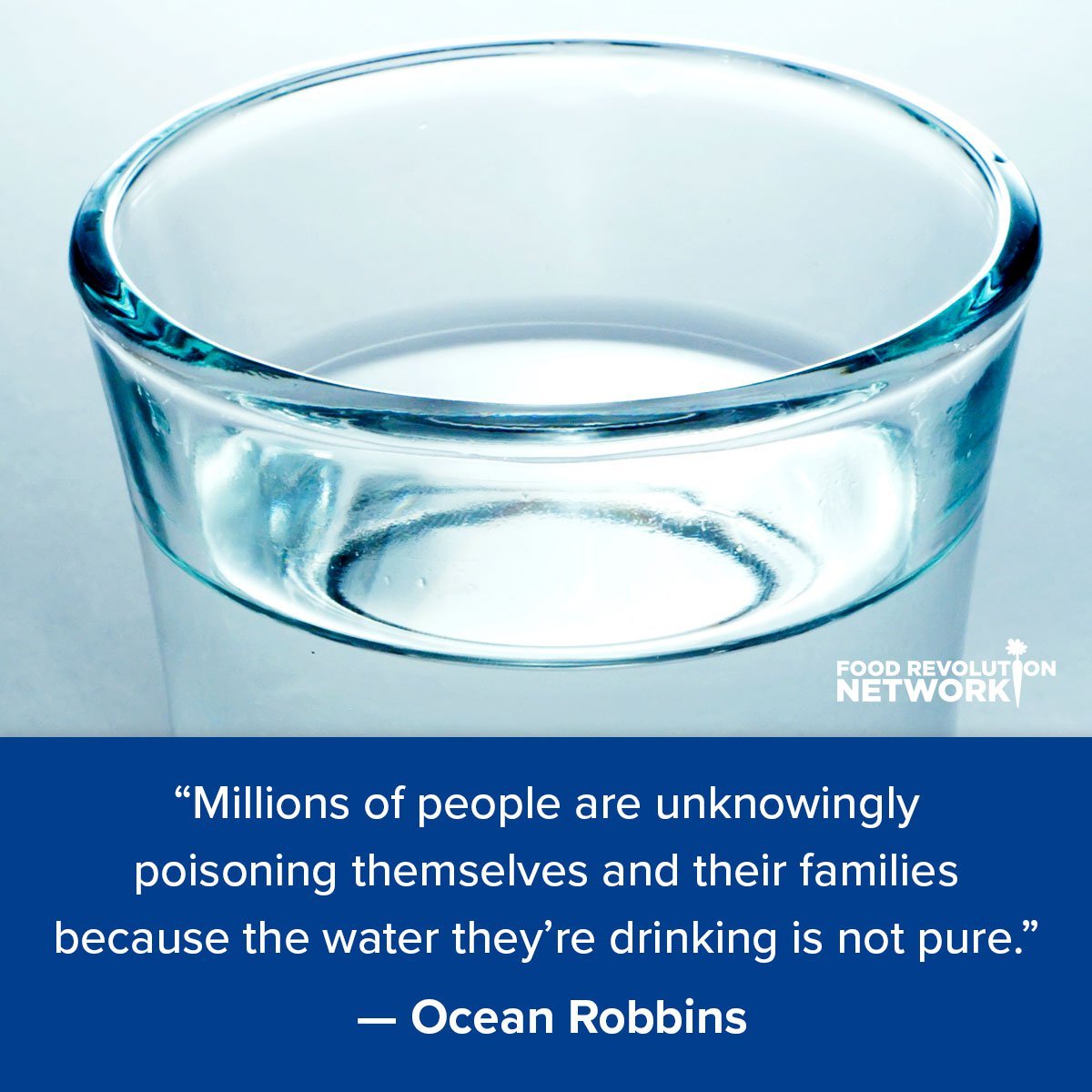Water is absolutely fundamental to long-term health.
The human body is about 60% water, and without it, a person will die within just a few days. Every single cell, tissue, and organ in your body needs water in order to function properly.
Each day, water:
- Delivers oxygen to your body
- Nourishes your body’s cells
- Helps flush out toxins
- Aids in a healthy digestive system
- Breaks down your food for nutrition
- Protects your vital organs
Some researchers also believe that water might be the most important “nutrient” for cancer prevention.
Research published in the Journals of Clinical Oncology found that the more water someone drinks, the less likely they are to develop bladder, colon, and breast cancers.
To retain good health, you need to stay hydrated by consuming water or beverages, along with foods that contain water.
Many health experts recommend that you drink eight to ten glasses of fluids per day. Unfortunately, most of us consume too much soda pop and other sugared drinks, alcohol, and sweet fruit juices, and not enough pure water.
Pure water is a powerful health-giving elixir. It hydrates your body and replenishes any water lost throughout the day.
Consuming sufficient quantities of water reduces fatigue, improves mood and digestion, and helps the body to flush out toxins.
Pure water is a powerful health-giving elixir. It hydrates your body and replenishes any water lost throughout the day.
Consuming sufficient quantities of water reduces fatigue, improves mood and digestion, and helps the body to flush out toxins.
Water contains no sugar or calories, and can also be used to make drinks, such as tea or coffee, each of which provides powerful health-promoting antioxidants and therapeutic phytonutrients. (In fact, the latest research indicates that drinking coffee in moderation may reduce the risk of several types of cancer.)
Most people understand that their body needs water to thrive, but sadly, millions of people are unknowingly poisoning themselves and their families because the water they’re drinking is not pure. A painfully high percentage of drinking water today is contaminated with chemicals or other pollutants.
Is Your Water Safe? The Truth About Drinking Water May Surprise You
While we know that water is critical to our survival, many of us have become removed and detached from understanding where our water is coming from. We’ve taken a passive, overly-trusting approach to the quality of water flowing into our homes and bottles.
Unfortunately, by not taking the time to research the quality of their water and the potentially harmful contaminants in it, countless people are placing themselves and their families at risk for a variety of devastating side effects, including cancer.
Lead in Water: It’s In More Places Than You Think
By not taking the time to research the quality of their water and the potentially harmful contaminants in it, countless people are placing themselves and their families at risk for a variety of devastating side effects, including cancer.
In 2015, Flint, Michigan suddenly dominated the news with headlines describing the high lead levels in the drinking water being served to the population, including children.
High lead levels can disrupt brain cells, lower IQ, and can lead to learning disabilities and behavior problems. Lead also removes the important zinc that the body needs in order to thrive.
But water contamination is not only in Flint. Not even close. According to an investigation published in The Washington Post:“Lead (now) taints water across the U.S., EPA records show.”
The piece goes on to describe that an estimated 20% of the water systems in the United States have been found to have unsafe lead levels.
Among these water systems, 350 daycares and schools failed lead tests a total of 470 times between 2012 and 2015. In New Jersey alone, 11 cities had a greater percentage of children with dangerously high lead levels than Flint.
Other Toxins That Could Be in Your Tap Water
Shockingly, lead is not the only contaminant that should concern people.
Recent tests have found that Chromium-6, the dangerous cancer-causing chemical made famous in the movie Erin Brockovich is contaminating the water supplies of more than 75% of all Americans.
Despite these tests, lobbying from industry and utility companies has prevented strong regulations that would bring the chromium-6 levels down into safe zones.
If these dangerous pollutants weren’t serious enough, studies also show that our water supplies contain a variety of other toxic chemicals, such as drug residues, including antibiotics, antidepressants, hormones from birth control pills, and painkillers.
Chemicals from rocket fuel (known as perchlorate) have been linked to thyroid problems in pregnant women and young children.
EPA studies have found that between 5 and 17 million Americans are exposed to perchlorate in their drinking water.

What About Bottled Water?
One of the most popular solutions for people, upon hearing of the dangers and the contaminants in our tap water, is to turn to bottled water.
Unfortunately, bottled water isn’t usually any safer – in fact, bottled water is often just high-priced tap water encased in plastic.
And it’s expensive. A single person drinking 8 glasses of bottled water a day would spend a minimum of $400 and as much as $1600 a year, depending on where it was purchased.
Bottled water also poses a risk for the environment with the disposal of the plastic bottles — in fact, an estimated 50 million plastic bottles end up in landfills every year.
What Can Be Done About It?
Despite being bombarded with new reports almost every week about the dangers in our drinking water, regulations and recommendations put forth by the EPA and the federal government are woefully inadequate.
Few changes have been enacted, and the average citizen remains almost totally uninformed about the quality and safety of the water they’re drinking.
Individuals, however, have the power to take the safety of their water into their own hands and protect themselves and their families.
Individuals have the power to take the safety of their water into their own hands and protect themselves and their families.
There are currently several different water filters available on the market, each with its own benefits and drawbacks.
Here is the Environmental Working Group’s basic overview of the most frequently seen types of water filters currently available.
Pitcher and Fridge Water Filters:
The most popular brands of pitcher water filters and fridge filters contain carbon.
- Benefits: These filters are designed to make water taste better by removing a few simple chemicals like chlorine.
- Drawbacks: They do not make water safer to drink and do not remove lead, chromium 6, or prescription drug residue.
Another type of pitcher water filter contains ion exchange material.
- Benefits: It will remove a limited number of organic contaminants, such as lead.
- Drawbacks: It does not remove chromium 6 or prescription drug residue; also, the filters need to be replaced every 15 gallons and are very expensive.
Distillation:
In this process, water is heated to vaporize and then condenses back into water.
- Benefits: This system will remove lead, chromium 6, and many bacteria and viruses.
- Drawbacks: This process cannot remove various VOCs, such as perchlorate or drug residue, it uses a significant amount of energy, and it is very slow to operate.
Ultraviolet:
These filters use ultraviolet light to purify water.
- Benefits: Ultraviolet light filters will kill bacteria and microorganisms.
- Drawbacks: Ultraviolet light will not impact any chemical pollutants from the water.
Carbon Filters:
There are many kinds of carbon filters, most of which are available in both under-sink and countertop models.
Activated carbon chemically bonds with and removes some contaminants in water filtered through it. But carbon filters vary greatly in effectiveness: Some just remove chlorine and improve taste and odor, while others remove a wide range of contaminants including asbestos, lead, mercury and volatile organic compounds (VOCs).
Generally, carbon filters come in two forms – carbon block and granulated activated carbon. Carbon block filters contain pulverized activated carbon that is shaped into blocks under high pressure. They are typically more effective than granulated activated carbon filters because they have more surface area.
- Benefits: A quality carbon filter can be a relatively economical way to remove many contaminants from water.
- Drawbacks: Activated carbon cannot effectively remove common “inorganic” pollutants, such as arsenic, fluoride, hexavalent chromium, nitrate, and perchlorate. Carbon filters also fill up with pollutants over time, so changing the cartridges regularly is essential.
Under-The-Sink Reverse Osmosis:
Under-the-sink reverse osmosis is always a combination of a reverse osmosis (RO) membrane and an activated carbon filter.
- Benefits: This is considered by many to be the gold standard of water filtration. The RO membrane removes all organic chemicals, such as lead, fluoride, and chromium 6. A high-quality VOC-activated carbon block filter will remove volatile organic compounds, such as prescription drug residue and perchlorate.
- Drawbacks: This option can be expensive and requires professional installation and maintenance. The system is generally inefficient and wastes four gallons of water for every one gallon of water created.
New Breakthrough — The AquaTru:
I’ve been researching the best home water filtration system for years, and the recently developed AquaTru is my top choice.
It’s a new countertop RO unit that includes excellent carbon filter technology, and delivers high-quality water and flavor, slashes the purchase cost, requires no installation fees, is remarkably water-efficient, and has extremely minimal maintenance costs.
The manufacturer, AquaTru, states that their water filtration system removes fluoride as well as chromium-6 and a great many other contaminants from your tap water. It’s available now for a $100 discount. If you’re interested, you can find out more here.
The Bottom Line
Water is life. It allows humans to grow and thrive. Unfortunately, most of our public water systems and many of our wells have become contaminated, and we have seen that we cannot look to the government to protect us.
And clearly, bottled water isn’t a sustainable or affordable option for most people. So what should you do to have safe drinking water?
If you want to protect your health and the health of your loved ones, you may want to look for the right water filtration system that will help purify your water, so you can avoid the dangers associated with these pollutants.
The best solution for you will depend in part on your location, the quality of your existing water supply, your financial resources, and your countertop space.
But drinking lots of good healthy water is a benefit you can’t afford to ignore. And it all starts with having an abundant supply of good-tasting water you can trust.
Tell us in the comments: Now that you know the truth about drinking water, what actions will you take to protect yourself and those you care about?


